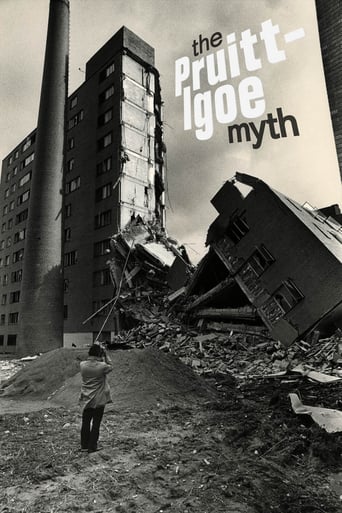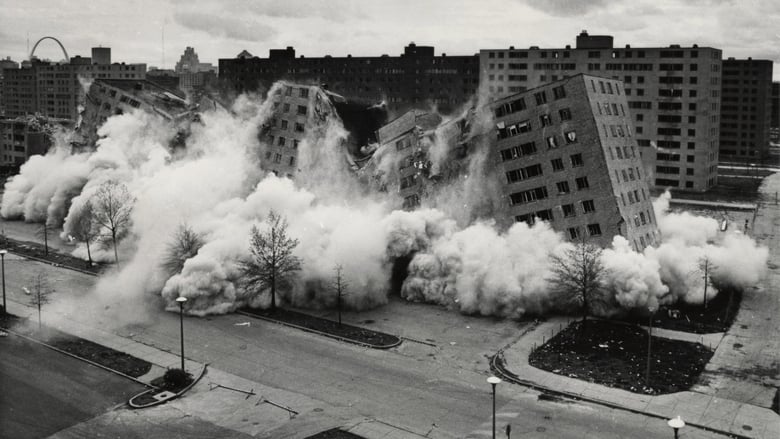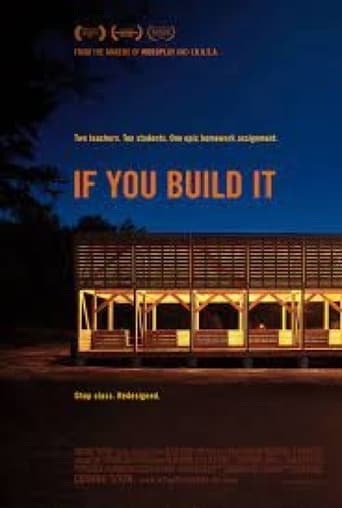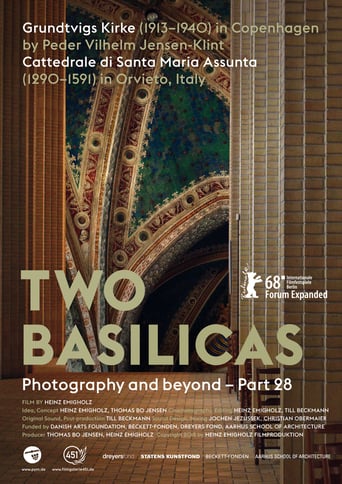

The Pruitt-Igoe Myth (2012)
Destroyed in a dramatic and highly-publicized implosion, the Pruitt-Igoe public housing complex has become a widespread symbol of failure amongst architects, politicians and policy makers. The Pruitt-Igoe Myth explores the social, economic and legislative issues that led to the decline of conventional public housing in America, and the city centers in which they resided, while tracing the personal and poignant narratives of several of the project's residents. In the post-War years, the American city changed in ways that made it unrecognizable from a generation earlier, privileging some and leaving others in its wake. The next time the city changes, remember Pruitt-Igoe.
Watch Trailer
Cast


Similar titles
Reviews
*MAY CONTAIN SPOILERS*Urban planning is never static; things are constantly changing. It is the appreciation of why certain projects lead to complete failure and some succeed. The cliché "We learn about the past in order to learn about the future" is a very prominent theme embedded within this documentary. In some aspects, the Pruitt-Igoe Myth is more lament than examination. Through the survivors' tales of death both literal and figurative, Benjamin Balcom's dismal score portrays everything as it is out to be. Directed by Chad Freidrichs, this grim but powerful documentary covers the domestic turmoil by punitive public welfare policies and the processes of mass suburbanization that emptied American cities. The Pruitt-Igoe housing had high hopes but empty promises. This housing project created the dream of a wonderful life. Although it did assert the importance of community, it backfired in vandalism, vacancy, and crime. The film starts off with Solvester Brown, a former resident of Igoe-Pruitt, revisiting the area for the first time in over 30 years. The plot he went to was almost unrecognizable; it consisted of a vacant "mini-forest" surrounded by piles upon piles of junk and mounds of concrete. The movie then cuts to a housing project video advertising the project, promising indoor plumbing, electric lights and other things expected in the 20th century. The sight that Brown witnessed did not match the promise that the planners put forth. Post WWII and the beginning of the Cold War, the Pruitt-Igoe housing project was created in response to the national urban renewal process of the 50's/60's. St. Louis's urban renewal plan was one of the most ambitious. Having major influence for coalition due to their wealth and power, civic leaders and politicians viewed the slums as eyesores and the downtown area was of their full interest. Urban reformers pressed lawmakers to input new clean modern homes to re-energize depression-era housing projects installed by war. The 1949 Housing Act was installed to bulldoze the slums and incorporated 800,000 homes within the United States that were supposed to ensure safe and affordable mortgages to low-income communities. The federal government funded the production of the project but didn't put money into the maintenance. So slumlords took advantage of the distressed residents and played a part with the worsening conditions of the apartments. Slumlords would pack as many people as they could within these buildings because they knew these people were desperate. World War II took a toll on St. Louis's economy. From 1970 to 1980, the population had decreased by 28 percent, beating Cleveland's and Detroit's downfall. Post war, urban growth reversed. The cities were losing the working middle class, their industrial base, and overall investment. National suburbanization policies, or urban flight, was made possible by the same housing act for Pruitt-Igoe. The appeal of the suburbs became the mainstream, and many families sprawled to the newly developed areas outside the city in hopes for more opportunities and overall a better life. Due to the disinvestment to the city and increase demand for the suburbs, land tax decreased in urban areas and thus leading to less money for maintenance. The unfortunate lower class that was left behind within the slowly rotting public housing. As if it couldn't get worse, the welfare department mandated that families living within the housing project qualify for aid only if there is not an able bodied male present. Women and children were the only residents allowed to reside. Families had to sacrifice a father figure in order for everyone to have somewhere to sleep. Televisions and phones were also violations of receiving aid. These harsh regulations created even more isolation than the community of Pruitt-Igoe was already in. This sense of hopelessness and alienation created a sense of imprisonment that further made people products of their environment, consisting of vandalism and no sense of safety. In short, this figurative prison is the effects of the welfare The residents of Pruitt Igoe found themselves in a prison they could not escape because of their income restraints.Pruitt was essentially clean at first, but maintenance declined shortly. There was never an adequate provision for maintenance. Solvester Brown recalled scratch-proof elevators evolving into urine-smelling that did not operate. Brown and his brother would be stuck in an elevator all day and would eventually have to pry the doors open and climb rope from floor to floor. The slumlords did not have sufficient amount of money to fund the operations nor did the state of Missouri. A representative from the St. Louis Housing Authority was interviewed in regards to the lack of federal investment of operations within the housing and he claimed that they "simply do not have enough money to operate as well as we should". He in front of a poor incinerator with mounds of garbage piling up as he was making this statement. Although the Pruitt-Igoe had the stereotype of a bad, unsafe place, the adversities that the residents dealt with created a strong sense of community. Everyone knew everyone, they were never alone. The implosion was devastating because the project was the solution, and it was very painful moment of trust to see that failure. This documentary portrayed the Pruitt-Igoe housing project well in the aspect of that it was a symbol for failed public housing as well as the proceed failure of well intentioned government policies in general. This shines a light on the responsibility for not for just the urban planners but for the country to learn from those failures and do better.
Prof. Cordova UPP 101 October 24, 2014In The Pruitt-Igoe Myth, director Chad Freidrichs, gives viewers an in-depth look at the Pruitt-Igoe project, one of St. Louis' failed attempts to urbanize the city. In this documentary, Freidrichs focuses on dispelling the myths that surround the project by interviewing past residents and establishing the real cause of why projects Pruitt-Igoe failed. In addition, this documentary sheds light on the bigger issue, of why housing projects in general fail in America.The main argument of the film is built to dispel the myths about housing projects, that Pruitt-Igoe fueled. When most people think about housing project and why they fail, they blame violence, crime, drugs, and poverty. While these things are commonly found in housing projects, they are not to blame. To prove this, Friedrichs starts by discussing the beginning of urban renewal. In 1949 the Housing Act was passed. Legalized and funded, St. Louis started urban renewal by clearing the slums and building new public housing units, Pruitt Igoe. Pruitt-Igoe was conceived to replace the tenement homes of poor residents throughout the St. Louis. The idea was to replace the slums with new high-rises, and this would solve the issue of poor neighborhoods. However this would not work out in the end. As I previously mentioned when people think of housing projects they think of crime as the root of their problem. This was not the case for Pruitt Igoe. Friedrichs points to a lack of funding as the cause of Pruitt Igoes failure in the documentary. The documentary looks in-depth at how a lack of funding led to the deterioration of Pruitt Igoe. They say the project was doomed from the beginning because the city did not have a solid plan on how to continue to fund Pruitt Igoe. When the planning for the building started, the city wrote in the plans that the rent residents would pay would never increase. As the years went on funding dwindled and the buildings deteriorated. The documentary interviewed some past residents and they told stories of how the grounds keepers stopped taking care of the building, no repairs or updates were made to the buildings, and how basically their was no one to take care of Pruitt Igoe. Another argument the documentary made was that people who live in housing projects have a community there. Many of the interviews shown in the documentary support this. Everyone they interviewed had positive happy memories of living in Pruitt Igoe despite poor conditions toward the end. They boasted of growing up there as children and always having someone to play with. The apartment styled building made it so everyone knew each other. Friedrichs use of interviews took the focus off of Pruitt Igoe being a failure and focused on the community aspect. Overall, this documentary dispels a lot of myths that surround housing projects. The documentary takes a look at a controversial aspect of urban planning over a course of decades in Pruitt Igoe. Many people put housing projects to the back of their mind or look at them as negatives blaming their problems on the residents that inhabit them. As a person who was grown and raised in St. Louis, I didn't even know that Pruitt Igoe existed as it has since been torn down. I would recommend this documentary, as I think it shows an important part of our history and portraits Pruitt Igoe in a positive light which it and its' residents deserve.
The Pruitt-Igoe Myth attempts to dispel some of the myths about that infamous housing complex in St. Louis. In particular it targets the inaccurate public perception of why government housing projects fail, while at the same time taking into account how the residents themselves felt about what they called home. In order to tackle the complexity of the issue, the documentary is structured in a chronological way, starting in the 1940's and concluding at the destruction of the complex in the 1970's.Pruitt-Igoe was commissioned to battle the lack of competent housing in St. Louis. To give a bit of background, St. Louis was a bustling industrial city for the first half of the 20th century. After a slump during the Great Depression, expectations were high for the growth of the city. The documentary emphasizes this idea of growth. It claims there was a culture of growth in St. Louis, with huge expectations of economic activity and population increases. Pruitt-Igoe was commissioned and built within this culture of growth. It was envisioned to replace the tenements that housed tens of thousands of poor residents throughout the city, and concentrate them within 33 high-rises on a large piece of urban land. There was great faith in Pruitt-Igoe. It was essentially supposed to be a solve-all. By adding competent housing into the equation, planners thought that these poor people would have a solid base to move up the socio-economic ladder, since the expectation was that jobs would be available. However, no one was able to envision the terror that was to strike St. Louis; the growth that was expected within the city did not happen.What occurred instead was the de-industrialization of the city. Though the causes of this de-industrialization are debatable, the documentary attributes it to a phenomenon called suburban sprawl. This storyline is not particular to St. Louis however, and similar effects were seen across the nation.The new level of post-war prosperity allowed millions of whites across the nation to afford green lawns and quiet communities in newly built sub-divisions. Industries followed these blue-collar workers, and cities were devastated. St. Louis lost 20% of its population by 1970. Cities like Detroit and Cleveland lost closer to a third. The tax bases of these cities were destroyed. Pruitt-Igoe was built with federal funds but maintained by rent income and local taxes. When the money dried up, which it did right away, the complex was left on its own. The residents blamed the Housing Authority, the Housing Authority blamed the city of St. Louis, St. Louis blamed the federal government, and the documentary blames white-flight. So why exactly did whites move? Some, including myself, would argue it was simple economics, because cheaper land was available outside city limits and the automobile made it possible to live in the suburbs and commute to work. The emerging middle class no longer had to live near industrial zones. However, the documentary contends that it was racially based. One white middle aged woman, when asked why she moved to the suburbs, replied "because I wanted to live in a white community." She went on to say that though she did not believe blacks should be oppressed, she could not live next to them. Another white woman interviewed expressed her fear of plummeting property values and crime when blacks moved into adjacent neighborhoods. No doubt the makers of The Pruitt-Igoe Myth included these interviews to advance the claim that Pruitt-Igoe failed due to racism. Yet this opinion seems to be on the fringe of moderate consensus, because where one chooses to live does not directly affect the life of another. Blacks were just as poor when whites lived in the city. The only difference was that in the case of Pruitt-Igoe, they were living in un-maintained high-rises built by whites. The failure of Pruitt-Igoe actually resulted from the ignorance of planners who did not consider the longevity of a place filled with the poorest of the poor. There was no way that these people would be able to maintain the buildings without federal aid. The city of St. Louis, faced with a plummeting population and tax base, could not do so either. The thesis of the documentary is that the failure of Pruitt-Igoe, though a disaster in itself, does not reflect disaster in every federally funded housing project. Though the cause of defending federal housing projects is admirable, the documentary makes the too-obvious argument that Pruitt-Igoe failed due to white-negligence. This sort of finger pointing does nothing to advance the situation of blacks. Nor does it take into account the very racist and segregationist nature of America in the first place. The majority of white Americans, both before and after Pruitt-Igoe, preferred to live in white communities. This is a trend that we still see to this day. So as long as planners huddle poor people into certain areas and expect something magical to happen, basic economics will reign supreme and these people will remain poor.
This has to be a valuable insight into how certain people expect everything handed to them on a plate.The documentary tries to blame the government and various social services for the failure of the project - In my opinion it fails! The blame for the failure lies squarely with the people who lived in the project.Everyone of them interviewed tries to lay the blame on the government, did the government urinate in the lifts? Did the government burn their refuse in the corridors, did the government break all of the windows and light fittings? No one involved seems to even begin to think that it is themselves to blame for all of this.Take a look at the project when it first opened, affordable clean housing, people wanted to live there.Give them a few years and they completely destroyed it.A very interesting insight into social behaviour.





